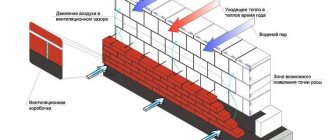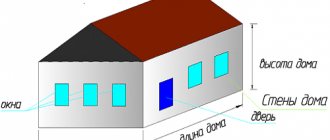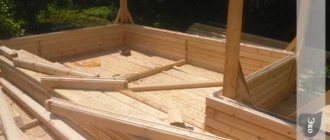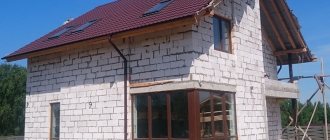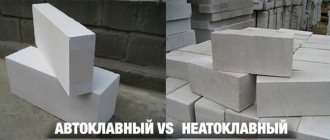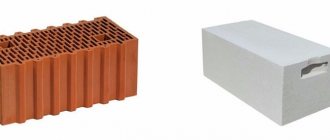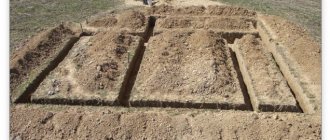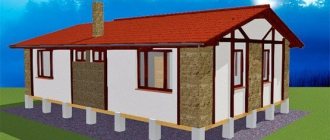Similarities and differences
Let's look at both materials, understand the difference between them, and make our choice: aerated concrete or gas silicate.
And further. Enough talking about the fact that the materials are new and it is unknown how long a house built from them will last.
Both aerated concrete and gas silicate were developed about 100 years ago. Technologies are proven and time-tested.
Comparison of formulations
Both aerated concrete and gas silicate are cellular building materials, but the difference in composition is very large.
However, the semantic meanings are so confused that, often, even sellers and manufacturers do not distinguish between gas silicate blocks and aerated concrete blocks by name.
However, Wikipedia makes it clear which is which.
Aerated concrete, as the name suggests, is one of the types of cellular concrete. Looks like a rock sponge. Main components: cement, quartz sand, special gas generators. The composition may also contain slag, ash, gypsum, and lime. Well, and various additives that improve the quality of the material.
Gas silicate is also a type of cellular materials, but not concrete! Based on: fine sand, lime, water, gas-forming additive (usually aluminum powder).
You can check here and here.
The difference between aerated concrete and gas silicate in production can also be very significant.
Comparison in production
Aerated concrete blocks and gas silicate blocks, despite the difference in composition, are made using the same technology up to a certain stage.
First, the components are mixed. Let us remember that in aerated concrete the base is cement, and in aerated silicate it is quartz sand and lime.
Next, the process of porosification occurs, namely, a gas-forming agent and alkali are added. As a result of the chemical reaction, hydrogen is released. And the mixture, with bubbles of this same hydrogen, freezes.
But then comes the time of autoclave hardening, which is mandatory for aerated silicate, but not for aerated concrete. This is such a big difference.
Autoclave hardening is the treatment of building blocks at high temperature under pressure in a sealed apparatus called an autoclave. The pressure reaches 0.8-1.3 MPa, and the temperature reaches 175-200°C.
This method is reliable, proven, and used in all large industries. During autoclave hardening, a new mineral is formed inside aerated concrete and gas silicate, which significantly increases their strength. In addition, the mixture hardens faster and the blocks obtained from it are much less susceptible to shrinkage in the future.
At the final stage, the frozen mixture is cut into finished products. Gas silicate or aerated concrete blocks made in this way are similar in their characteristics.
In the case of non-autoclave, natural hardening, which is only suitable for aerated concrete, the building blocks will be much less durable, and a house built from them will shrink for some time. It is also worth noting that non-autoclaved aerated concrete blocks are often made in small industries and even directly on the construction site. In this option, the aerated concrete mass is poured into ready-made cells, in which the formed building blocks harden naturally.
How to distinguish
The obvious difference between gas silicate blocks and autoclaved aerated concrete blocks is the same color. Gas silicate - white, aerated concrete - grey.
If you look at how a gas silicate block differs from a non-autoclaved aerated concrete block, there will be more differences
Gas silicate has an even shape. A non-autoclave hardened gas block may have an unclear geometry, there may be unevenness along the planes, and there is a greater likelihood of small chips.
Since a lot depends on the forms for pouring the mixture, which are not always ideal, and the likelihood of small and not so minor errors increases.
Area of use of gas silicate blocks and aerated concrete
The performance properties of promising building materials determine their wide scope of application:
- housing construction;
- construction of industrial facilities;
- construction of public premises;
- construction of sports facilities;
- construction of commercial centers.
The area of use of the material is also affected by its specific gravity:
- Heavy blocks with increased density are classified as products for structural purposes. Characterized by increased strength, they are used for the construction of capital walls and the construction of partitions;
- aerated concrete blocks and medium-density gas silicate products are classified as structural and thermal insulation. They are used in private construction, used for the construction of cottages and low-rise buildings;
- reduced density is typical for thermal insulation materials with a low thermal conductivity coefficient. The blocks are used as thermal insulation and are not used for the construction of loaded structures.
Pros and cons of gas silicate blocks
Main Pros.
- Light weight with sufficient strength. Which simplifies the construction process.
- Environmentally friendly. Only environmentally friendly materials are used in production.
- Good heat-saving and sound-insulating properties. This is due to the pores.
- Non-flammability. Gas silicate is, although artificial, a stone.
Main Cons.
- Fragility. This affects the construction process, you need to be careful. And, what is much more significant, there will be difficulties during operation. Namely, you will have to use special fasteners; ordinary ones will not help.
- High water absorption. High-quality waterproofing is required.
Summing up - what to choose, aerated concrete or gas silicate
When deciding on the choice of material for the construction of a building, many people prefer aerated silicate, which is superior to aerated concrete in many characteristics. Silicate products are produced at industrial enterprises, where quality is controlled in the laboratory, and special equipment is used in the manufacturing process. Naturally, this is reflected in the price. At the same time, aerated concrete is also popular in the field of housing construction. Developers are attracted by the affordable price and reduced hygroscopicity.
Both materials are used to solve different problems. It is important to study the properties and adhere to the technology requirements during construction.
Comparison of characteristics
Autoclaved gas silicate blocks and autoclaved aerated concrete blocks are almost identical in their characteristics. Therefore, we will compare autoclaved gas silicate blocks and non-autoclaved aerated concrete blocks.
Dimensions
Gas silicate blocks and aerated concrete blocks do not differ in size according to GOST. The values are as follows, in mm:
250*250*600.
250*400*600.
500*200*300.
600*100*300.
600*200*300
The most commonly used is 600*200*300.
But, in fact, there are no strict standards, and in practice you can find a variety of sizes. This is especially true for gas blocks produced in small factories.
Strength
The gas silicate block is many times stronger. This is its main advantage over the gas block.
As for the general strength indicator, it directly depends on the density of the material. The higher the density, the fewer bubbles the blocks contain. It turns out that the stone component of the blocks will be more durable due to the fact that the bridges between the bubbles are thicker. The difference is small - up to 1 mm. But due to the number of these jumpers, the effect of strengthening the structure is obtained.
A very important remark must be made here. The tensile strength of both blocks is extremely low. Compression performance is better.
Thermal conductivity
There is no particular point in comparing aerated concrete or gas silicate blocks in terms of thermal conductivity, which is better and more reliable. Both perfectly retain heat inside the house.
By the way, there is an inverse relationship between thermal conductivity and the density of building materials. The stronger the block, the denser and heavier it is. And, accordingly, there are fewer voids in it. This suggests that the higher the grade of the block, the worse it retains heat.
Fire resistance
Gas silicate and aerated concrete blocks are non-flammable.
Manufacturers often publish the results of numerous tests. They all claim that a gas silicate slab 1 cm thick can last under fire for 2 hours. This is before the material is destroyed, that is, before cracks appear. Non-autoclaved aerated concrete has worse performance, but is also quite good.
By the way, behind such a wall it is quite possible to hide from a fire. The cavities inside the wall will act like the walls of a thermos, allowing only a small portion of the heat to pass through.
Moisture resistance
The level of water absorption is increased. Both materials absorb moisture. This will lead to the formation of mold and mildew. Strength will also decrease. High-quality waterproofing is required.
Vapor permeability
Present. And that's not a bad thing. They say that a house made of cellular materials “breathes,” which creates a good microclimate inside.
Frost resistance
The difference between gas silicate and aerated concrete is significant here.
A non-autoclave aerated block has very decent frost resistance, up to 75 cycles.
But for gas silicate it reaches 150 cycles.
The indicator is more technical, not mundane.
Frost resistance means how many freezing cycles a material can “survive” painlessly and not begin to deteriorate. The main enemy of the material is ice. Moisture, crystallizing, expands the concrete, causing the partitions between the bubbles to break, thereby weakening the strength of the structure. But, in fact, complete wetness almost never occurs. Only in case of a flood, perhaps.
Note that the higher the brand of the block and its density, the higher the frost resistance index.
Soundproofing
Aerated concrete and gas silicate are porous structures. Both places have excellent sound insulation. True, there are some differences; in this category, gas silicate is somewhat inferior to aerated concrete. The second has a softer structure, which is why sound vibrations are better damped.
Shrinkability
Here the gas block definitely loses to the gas silicate one. If for the first it is about 0.5 mm per meter, then for the second it is about 3 mm per meter.
Environmental friendliness
The blocks are made from natural materials, and after processing they do not release any substances into the surrounding air. Houses built from such building blocks are absolutely environmentally friendly.
Appearance
Differences in color. Gas silicate - white, aerated concrete - gray. But that's not the main thing. Non-autoclaved aerated concrete is almost certainly more uneven. And this can be of great importance during laying, because non-ideal geometry complicates the process and increases glue consumption.
Price
Of course, non-autoclaved aerated concrete is cheaper. There are objective reasons for this, listed above.
What is the difference between aerated concrete and gas silicate - comparison of characteristics
Trying to figure out how gas silicate products differ from aerated concrete materials, let’s consider the main characteristics of porous concrete:
- strength. Silicate blocks are much stronger than aerated concrete products, since in a gas-silicate mass the air cells are distributed more evenly;
- thermal insulation properties. Gas silicate blocks have superior thermal insulation characteristics to aerated concrete, which is also due to their structure;
- frost resistance. Aerated concrete is able to maintain its integrity during repeated freezing with further thawing, surpassing silicate;
- weight. The weight of aerated concrete differs slightly from aerated silicate. The products do not place an increased load on the foundation of the building;
- shape and dimensional tolerances. Gas silicate blocks are characterized by correct geometry and small dimensional tolerances, which makes masonry easier;
- aesthetics. Buildings made of snow-white gas silicate look much more attractive. They benefit when compared to gray aerated concrete buildings;
- fire resistance. Both types of products are fireproof products, having increased resistance to high temperatures and open fire;
- durability. Aerated concrete and gas silicate are widely used in construction, equally ensuring a long service life of buildings.
Non-autoclaved aerated concrete is the least durable and, compared to gas silicate, not of the highest quality
The cost of materials plays an important role. With the same dimensions, aerated silicate products are more expensive compared to aerated concrete. This is due to production technology.
What to choose
If we choose between autoclaved aerated concrete and gas silicate, then, as noted above, their characteristics are very similar. Therefore, in this case, we look at the performance of blocks from specific manufacturers. We choose those whose parameters are better. And it doesn’t matter what it will be, aerated concrete or gas silicate.
If we choose between autoclaved gas silicate and non-autoclaved aerated concrete, there is already something to think about.
It is worth thinking about sufficient feasibility. Gas block is less durable, but cheaper. Somewhere its characteristics will be sufficient, and there is no point in overpaying. Well, where strength is critically important, only gas silicate or autoclaved aerated concrete.
What do aerated concrete and gas silicate have in common?
The main common feature of the materials is the similar values of their characteristics. The need for structural products that will help save on energy costs is pushing developers to search for materials with an optimal price/quality ratio.
Composition and properties of materials strengths and weaknesses
To summarize, gas silicate is aerated concrete processed in an autoclave - a device for rapid hardening of the material at elevated pressure and temperature. The difference between aerated concrete and gas silicate lies in the features of the production process.
Aerated concrete, like aerated silicate, is a type of cellular concrete that has a porous structure. Thanks to this feature, the material is light but at the same time durable. Due to the presence of voids in the blocks, they have low thermal conductivity.
A solution of gas silicate and aerated concrete is a mixture of the following materials:
- cement;
- sand;
- lime;
- water;
- gas generator – aluminum powder or paste;
- special additives to increase the numerical values of the desired characteristics.
Since the parameters of products made from gas silicate and gas blocks are quite similar, it is worth highlighting the general advantages of slightly different materials:
- Low thermal conductivity coefficient, which, according to GOST for cellular concrete, starts at 0.09 W*mS.
- Frost resistance. The technical documentation for each material indicates the minimum number of freeze-thaw cycles - 25. In practice, this number differs from one manufacturer to another. Due to high competition, this figure usually exceeds 50, regardless of the type of aerated concrete blocks.
- Optimal density is indicated by the letter D. It is in the range of 300-1200 kg/m3. The densest products are used in the construction of walls. For insulation, blocks with a lower index are used.
- Durability brand. According to GOST, it is B1.5 - B15.
- Environmentally friendly. According to this indicator, cellular concrete is inferior to wood by only 1 point.
- Non-flammable.
- The simplicity of creating masonry is explained by the ease of sawing and grinding the materials. When working with aerated concrete and gas silicate, there is no need to use special equipment.
- The high speed of construction is due to the simple technology of laying blocks and the optimal dimensions of the products.
The common advantage of both materials is their availability, which is explained by the wide choice of manufacturers. Due to the popularity of the materials, they are produced in the form of wall products and U-shaped elements.
General disadvantages of gas silicate and aerated concrete:
- High fragility. When transporting products, they are often subjected to mechanical stress, which leads to the formation of chips and an increase in the number of rejected blocks.
- High degree of water absorption. Since the materials are hygroscopic, they quickly absorb moisture, which requires careful protection. With prolonged exposure to water, products gradually deteriorate.
- Difficulty in securing various objects to walls made of cellular material.
- Low degree of adhesion with finishing materials.
- Susceptibility to shrinkage and cracking as a result of this process.
Considering the general disadvantages of gas blocks, you can focus on construction possibilities.
Types and scope of application of both materials
Since aerated concrete and aerated silicate blocks are types of cellular concrete, one classification has been developed for them:
- Structural products have high strength and the ability to withstand significant loads. The thermal conductivity of such products is higher than that of other types.
- Structural and thermal insulating gas silicate and aerated concrete are more often used by developers, since their use reduces the cost of insulation.
- Thermal insulating cellular concrete is characterized by a high degree of thermal insulation.
Gas silicate or aerated concrete blocks are often used for the construction of the first and second floors of country houses and outbuildings. Knowing the difference between them, you can determine specific construction tasks.
What to look for when purchasing
Let's list the main points.
- Geometry. Extremely important for future construction. The laying is carried out on a thin layer of glue, the thickness of which may not be enough to smooth out irregularities. You will have to either increase the thickness of the adhesive composition, which is not good, or trim off the protruding parts, which will significantly complicate and lengthen the construction process. Well, indirectly, even blocks are a sign of solid production.
- Density of the material. The denser the blocks, the stronger they are. And more expensive, by the way. However, do not forget that an increase in strength entails a decrease in thermal insulation qualities. Therefore, with cellular building materials, as a rule, it is better to play it safe and choose the most durable one, which does not work very well. We need a middle ground: strong enough and good thermal insulation.
- Size and type. It is especially important if you plan to lay the masonry yourself, to choose a size that is comfortable for you. And it will be decided whether these will be ordinary blocks or tongue-and-groove ones.
- Manufacturer. Big companies don't cut corners. For little-known brands, stricter checks and controls are required.
Features of the production technology of aerated concrete and gas silicate and products made from them
According to the manufacturing method, gas silicate differs little from aerated concrete. The process differs only in the final stage.
You can distinguish a gas silicate block from an aerated concrete block by the manufacturing process.
Equipment and materials
Cellular concrete is produced using various equipment:
- Conveyor. It is highly expensive.
- Stationary lines have lower productivity, but the contributions to them are significantly lower than those of a conveyor.
In addition to the set of equipment, for the production of cellular blocks it is necessary to prepare loaders, trucks, and devices that are not included in the standard package.
Production process progress
The sequence of manufacturing aerated concrete and gas silicate:
- From storage bins, raw materials enter the dispenser. It is then sent to a mixer where the components are mixed.
- After mixing is complete, a gas-forming agent is added to the composition.
- Concrete is poured into molds 1/3 full. They are not filled, since when swelling the solution will increase in volume.
- After filling the form with the solution, it is necessary to remove the excess.
- Concrete layers are cut into standard sizes.
- The final stage of gas silicate production is the autoclaving process. It is at this stage that the main difference between gas silicate blocks and aerated concrete blocks lies. The products are then sent to the finished goods warehouse.
Cellular concrete blocks can be stored both indoors and outdoors. The only condition is that they must be protected from moisture. It is recommended to use finished products in construction only 28 days after production.
Advantages and disadvantages of aerated concrete and gas silicate blocks
Due to the similar structure and chemical composition of aerated block and gas silicate, both materials have the same advantages:
- High rate of heat and sound insulation.
- No harmful impurities for humans.
- Ease and speed of installation. The construction period is reduced several times. There are many video reviews on Youtube where one person builds the walls of a one-story house covering 150 km² during his vacation.
- Strict geometry of shapes. The deviation of blocks from a good manufacturer is no more than 1 mm.
- Not susceptible to combustion processes.
- Possibility of processing and cutting using a hand saw.
- High coefficient of vapor permeability.
- Thanks to a thin layer of masonry joint, “cold bridges” are minimized.
- Frost resistance.
- Acceptable prices.
- Standard sizes for all manufacturers make the process of independently calculating the material simple.
The situation is similar with disadvantages. They are identical:
- High hygroscopicity (the ability to absorb moisture from the air, inherent due to the cellular structure).
- Increased fragility. A wall made of aerated concrete or gas silicate reacts sharply to the slightest vibrations of the foundation.
- Mandatory priming before plastering. Otherwise, the applied layer will peel off in the first year of operation.
- Low compressive and flexural strength.
The last disadvantage of porous concrete is that special hardware is used as fasteners for shelves, mirrors and other things, the price of which is higher than usual.
Gas silicate blocks: characteristics
Density of gas silicate blocks
The brand and density of gas silicate blocks is indicated in the marking and determines the purpose of the block:
- structural gas silicate blocks – D1000-1200, have a density from 1000 to 1200 kg/m3;
- structural and thermal insulation blocks – D500-900, have a density of 500-900 kg/m3;
- thermal insulation D300-D500, the density of their materials is 300-500 kg/m3.
Blocks of different densities are easy to distinguish from each other visually.
There are several classifications of gas silicate blocks with certain technical characteristics. Today, the following grades of this material are used in construction work. The best option for low-rise construction is the d500 gas silicate block and the d600 gas silicate block.
The digital designation of the brands listed earlier shows the density of the material. In particular, the d500 gas silicate block has a density of 500 kg/m³.
Gas silicate block d600
Gas silicate block d600 is used in the construction of load-bearing walls of a house. It is also recommended for use in the construction of ventilated facades, which are well attached to blocks of such density. The d600 gas silicate block has a strength of 2.5-4.5 MPa and has a thermal conductivity of 0.14-0.15 W/(m°C)
Gas silicate block d500
Gas silicate block d500 is most popular for low-rise (up to 3 floors) construction. This variety is also used in monolithic construction. Its parameters are 2-3 MPa (strength) and 0.12-0.13 W/(m°C) (thermal conductivity).
When building a house higher than three floors, you should give preference to gas silicate with a marking higher than D600 and additionally insulate the walls. Based on the value of the thermal conductivity coefficient, we can conclude that the d500 gas silicate block is 15-17% warmer than the d600 gas silicate block.
Gas silicate block d400
This type is used for arranging insulation and for working with openings during the construction of multi-storey buildings using the monolithic method. The D400 brand is also popular in private construction. With high strength, it has great heat-insulating properties. These indicators are in the range of 1 MPa to 1.5 MPa (strength), 0.10-0.11 W/(m°C) (thermal conductivity).
Gas silicate block d300
Brand D350 can only be used as insulation. This is a rather rare brand on the domestic market, due to its fragility. Strength is in the range of 0.7-1.0 MPa. But it differs in thermal conductivity, which is 0.08-0.09 W/(m°C).
Thermal conductivity of gas silicate blocks
Depending on the proportions of the starting ingredients, you can obtain a product with different performance characteristics. The thermal conductivity coefficient of a gas silicate block depends on its density and is determined by the marking: D300, D400, D500, D600, D700.
The thermal conductivity of gas silicate depends on a number of factors:
- Dimensions of the building block. The greater the thickness of the wall block, the higher its thermal insulation properties.
- Ambient humidity. Material that has absorbed moisture reduces its ability to store heat.
- Structure and number of pores. Blocks that have a large number of large air cells in their structure have increased thermal insulation properties.
- Density of concrete partitions. Higher density building materials retain heat less well.
Thermal conductivity table for gas silicate blocks
Features of materials
Many builders have difficulty distinguishing whether aerated concrete or gas silicate is in front of them at the moment. The reason for this is the significant external similarity of the materials, as well as the same performance qualities. Disputes about which one is better, higher quality and more efficient have not ceased since the advent of manufacturing technology. At the same time, from the point of view of performance, both materials have the same advantages:
- light weight;
- high heat-saving ability;
- smooth, precise shape, eliminating thick masonry seams;
- the ability to muffle extraneous sounds;
- high speed of construction, big savings on building materials.
However, there are also serious disadvantages:
- ability to absorb water in large volumes;
- low strength and load-bearing capacity;
- You cannot use regular masonry mortar for installation; you need a special adhesive composition.
It is noteworthy that the disadvantages are a direct consequence of the advantages of the materials. Gas blocks and gas silicate blocks can show their best qualities only with a maximum of shortcomings. Attempts to eliminate the disadvantages result in a loss of advantages, making the production of such materials impractical.
Production technology
The reason for the confusion is the general production technology of all types of cellular concrete. The differences are minor; they relate to the specifics and composition of the materials. The general scheme remains unchanged:
- a working mixture is prepared;
- a gas-forming agent is added to it (usually it is a paste based on aluminum powder);
- a chemical reaction begins, during which the concrete rises like yeast dough;
- at the end of the reaction, the large workpiece is cut into blocks, slabs or other fragments and sent for crystallization in an autoclave (treatment with hot steam under pressure) or for drying without pressure, only under heat;
- after 12 hours of exposure, ready-made blocks of one or another material are released from the autoclave.
Any cellular concrete is made using this method. The resulting material has very useful qualities, and the only thing that distinguishes aerated concrete from gas silicate is the composition of the molding mixture. There is one more technological difference - a gas silicate block can only be produced using the autoclave method, while an aerated concrete block can be produced using both autoclave and non-autoclave methods.
It is noteworthy that modern types of cellular concrete are produced using the autoclave method. This is the most effective and cost-effective technology that produces repeatable results. The choice of manufacturers was also influenced by the low quality assessment of non-autoclave grades of material, which caused a drop in demand.
Advantages of aerated concrete
Even taking into account the lower strength and thermal insulation parameters, there are differences between aerated concrete and gas silicate that speak in favor of the first material:
- Moisture absorption. Such products have a low level of moisture absorption, which is due to the smaller volume of pores in the structure of the products. But when using them, it is necessary to create a special protective coating;
- Price. The most significant factor influencing the choice of material is its cost. In this regard, aerated concrete is more accessible;
- Frost resistance. Aerated concrete has increased resistance to negative temperatures, which is necessary for the use of building materials in regions with harsh climates. This is due to its ability to withstand repeated freezing followed by thawing without losing its integrity;
- Fire resistance. Considering that gas silicate also has good resistance to fire, aerated concrete has better resistance to elevated temperatures, as well as open fire.
Considering the difference between gas silicate blocks and aerated concrete blocks, it is worth noting that both types of materials, when used correctly, provide a long period of operation of the building.
Specifications
Gas silicate or aerated concrete buildings - in any case, the materials have certain properties. They are close to each other, but there are some differences. For ease of comparison, which is better, gas silicate or aerated concrete, let’s make a small table with the main parameters of both types:
| Characteristics | Aerated concrete | Gas silicate |
| Specific gravity (grade D500) | 500 kg/m3 | 580 kg/m3 |
| Water absorption | 16-25% by weight of dry sample | 25-30% by weight of the dry sample |
| Compressive strength | 1.5-2.5 MPa | 1-5 MPa |
| Vapor permeability | 0.12 Mg/(m hour MPa) | 0.17-0.25 Mg/(m hour MPa) |
| Frost resistance | 35 cycles | 35 cycles |
| The thickness of the masonry required to obtain the same microclimate with equal thermal conductivity of materials | 40 cm | 30 cm |
Analyzing the table data, it can be noted that silicate and aerated concrete blocks have approximately equal parameters. Gas silicate is somewhat heavier, but it retains heat more effectively and exhibits greater compressive strength. However, builders treat it with distrust due to its high hygroscopicity. For example, using the higher strength of an aerated silicate block, it would be possible to bypass the restriction on the number of storeys of houses (up to 3 floors) that applies to aerated concrete. However, protecting a gas silicate block from moisture is much more difficult. It actively absorbs not only liquid, but also atmospheric humidity, which causes the walls to get wet and freeze. In Russian conditions, the use of such material becomes too risky, and only professional builders can perform high-quality waterproofing and waterproofing.
The main reason why gas silicate differs from aerated concrete is the composition of the components of the original mixture. For the production of aerated concrete the following is used:
- Portland cement;
- quicklime;
- quartz sand;
- gypsum;
- water;
- aluminum powder.
This is a classic composition that has been used since the early days of aerated concrete production. The gas silicate block is made from the following mixture:
- quartz sand;
- quicklime;
- gypsum;
- aluminum powder;
- water.
It is noticeable that gas silicate differs from aerated concrete only in the absence of cement. This explains the discrepancies in the properties of the final product with the same production technology. It is also necessary to take into account the difference in the parameters of autoclaved and non-autoclaved aerated concrete - the first is stronger and has a higher load-bearing capacity.


